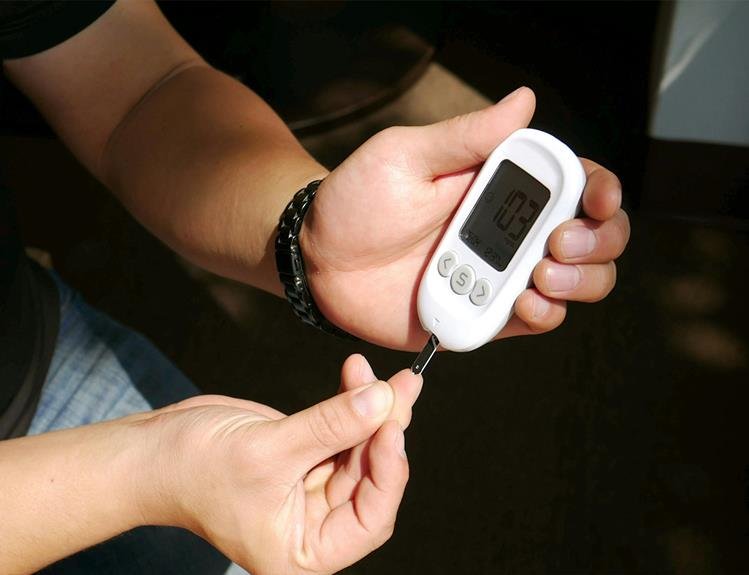Exploring the Different Types of Diabetes Neuropathy
If you have diabetes, you might be familiar with Peripheral Neuropathy, but did you know there are various other types of diabetes-related nerve damage that can occur?
Each type presents its own set of symptoms and challenges that can impact your daily life. Understanding the differences between these neuropathies can help you manage your condition more effectively and potentially improve your quality of life.
Stay tuned to uncover the nuances of these different types and how they uniquely manifest in individuals with diabetes.
Peripheral Neuropathy
Peripheral neuropathy affects the nerves in your extremities and can cause numbness, tingling, and pain. This condition is common in individuals with diabetes, resulting from high blood sugar levels damaging the delicate nerve fibers. The symptoms often start in the toes and feet, gradually progressing up the legs. You may experience a loss of sensation, making it difficult to feel heat, cold, or even touch. This can lead to injuries or infections that go unnoticed due to the lack of feeling.
As peripheral neuropathy advances, the pain can become more intense, feeling like sharp stabbing or burning sensations. It may disrupt your sleep and daily activities, impacting your quality of life. Simple tasks such as walking or buttoning a shirt can become challenging. Managing your blood sugar levels through medication, diet, and exercise is crucial in preventing further nerve damage. Regular monitoring and foot care are also essential to catch any issues early and prevent complications.
Autonomic Neuropathy
Autonomic Neuropathy affects the nerves that control internal organs, leading to symptoms like digestive issues, dizziness, and abnormal sweating patterns.
Treatment options for Autonomic Neuropathy may include managing blood sugar levels, medications to alleviate specific symptoms, and lifestyle adjustments to improve overall health.
Understanding the signs and seeking medical advice promptly can help in effectively managing Autonomic Neuropathy's impact on your daily life.
Symptoms of Autonomic Neuropathy
When experiencing autonomic neuropathy, you may notice a range of symptoms affecting various bodily functions. These can include digestive issues like bloating, constipation, or diarrhea. You might also experience dizziness or lightheadedness upon standing due to blood pressure fluctuations.
Additionally, bladder problems such as urinary retention or incontinence may arise. Sexual dysfunction, such as erectile dysfunction in men or vaginal dryness in women, could also be present. Sweating abnormalities, where you either sweat excessively or very little, are common.
Heart rate irregularities, like a rapid heartbeat or feeling your heart flutter, may occur. It's essential to recognize these signs to seek appropriate medical attention and management.
Treatment Options Available
To address autonomic neuropathy symptoms effectively, medical interventions and lifestyle adjustments can be crucial in managing the condition's impact on your daily life.
Medications such as certain antidepressants, anticonvulsants, or alpha-lipoic acid may help alleviate symptoms like digestive issues, dizziness, or urinary problems. Your healthcare provider might recommend dietary changes, like increasing salt intake to manage low blood pressure, or suggest physical therapy to address muscle weakness.
Managing blood sugar levels effectively through diet, exercise, and medication can also play a significant role in controlling autonomic neuropathy symptoms. Additionally, practicing good foot care, staying hydrated, and avoiding excessive alcohol consumption can help prevent complications associated with autonomic neuropathy.
Regular monitoring and open communication with your healthcare team are essential in optimizing your treatment plan.
Proximal Neuropathy
Proximal Neuropathy typically manifests as pain, weakness, or numbness in the thighs, hips, or buttocks. It's often referred to as diabetic amyotrophy. This type of neuropathy usually affects one side of the body and can gradually spread to the other side over time. The pain associated with proximal neuropathy is often described as deep, aching, or stabbing.
Individuals with proximal neuropathy may experience difficulty rising from a sitting position, climbing stairs, or walking. The weakness in the muscles of the affected areas can lead to decreased mobility and coordination. Numbness in the thighs, hips, or buttocks can also occur, making it challenging to feel sensations such as touch, pressure, or temperature changes.
Managing proximal neuropathy involves controlling blood sugar levels, pain management strategies, physical therapy, and lifestyle modifications. It's crucial to work closely with healthcare providers to develop a comprehensive treatment plan tailored to your specific needs. Early intervention and consistent monitoring can help alleviate symptoms and improve overall quality of life.
Focal Neuropathy
Focal Neuropathy can cause sudden, localized nerve damage in various parts of the body. Unlike other forms of diabetic neuropathy that develop gradually, focal neuropathy typically affects specific nerves, leading to intense pain and muscle weakness. This condition may occur in different areas such as the head, torso, leg, or hand, and the symptoms can vary depending on the nerve affected.
Common symptoms of focal neuropathy include sharp, stabbing pain in a specific area, muscle weakness, and difficulty moving the affected body part. For example, if the nerves in your wrist are affected, you may experience pain and weakness in your hand and fingers. Focal neuropathy can also lead to other issues like double vision, difficulty focusing your eyes, or pain behind one eye.
Treatment for focal neuropathy may include pain management strategies, physical therapy to improve muscle strength, and in some cases, surgical interventions to relieve pressure on affected nerves. It's essential to work closely with your healthcare provider to develop a personalized treatment plan that addresses your specific symptoms and needs.
Diabetic Amyotrophy
If you've experienced unexplained pain and weakness in your thigh or buttock muscles, you may be dealing with a condition known as diabetic amyotrophy. Diabetic amyotrophy, also called proximal neuropathy, is a type of nerve damage that affects the muscles in the lower part of your body. This condition often occurs in people with type 2 diabetes and can lead to significant discomfort and difficulty moving.
The exact cause of diabetic amyotrophy isn't fully understood, but it's believed to be related to high blood sugar levels and damage to the blood vessels that supply nerves. Symptoms of diabetic amyotrophy can include severe pain, muscle weakness, and atrophy in the thigh and buttock area. These symptoms can significantly impact your daily activities and quality of life.
Treatment for diabetic amyotrophy focuses on managing your blood sugar levels and relieving pain. Physical therapy and medications may also be recommended to help improve muscle strength and function. It's essential to work closely with your healthcare provider to develop a comprehensive treatment plan tailored to your needs.
Mononeuritis Multiplex
Now, let's talk about Mononeuritis Multiplex. This condition involves damage to multiple individual nerves, leading to symptoms like sudden pain, weakness, and numbness in various parts of your body.
Understanding the causes, risk factors, and available treatment options for this type of neuropathy is crucial for managing its effects on your daily life.
Nerve Damage Symptoms
Symptoms of nerve damage in Mononeuritis Multiplex can vary depending on the nerves affected and may include sudden pain, weakness, or numbness in specific areas of the body. Unlike other forms of diabetic neuropathy that often affect both sides of the body symmetrically, Mononeuritis Multiplex typically causes asymmetric symptoms.
You may experience sharp, shooting pains that come on suddenly in one area, followed by weakness or numbness. These symptoms can affect different parts of the body at different times, making it challenging to predict how they'll progress.
It's essential to seek medical attention if you notice these symptoms, as early diagnosis and treatment can help manage the condition effectively and prevent further nerve damage.
Causes and Risk Factors
Moving from discussing symptoms of nerve damage in Mononeuritis Multiplex, understanding the causes and risk factors for this condition is crucial.
In this type of diabetic neuropathy, Mononeuritis Multiplex, the primary cause is damage to individual nerves due to prolonged high blood sugar levels. The most significant risk factor for developing this condition is uncontrolled or poorly managed diabetes. Additionally, other factors such as high blood pressure, smoking, and obesity can further increase the risk of developing Mononeuritis Multiplex.
It's essential to manage diabetes effectively through medication, diet, and lifestyle changes to reduce the risk of developing diabetic neuropathies like Mononeuritis Multiplex. Regular monitoring and control of blood sugar levels are key in preventing nerve damage complications.
Treatment Options Available
For effective management of Mononeuritis Multiplex, various treatment options are available to alleviate symptoms and prevent further nerve damage. Treatment typically involves addressing the underlying cause, such as controlling blood sugar levels in diabetes or treating underlying infections or autoimmune conditions. In some cases, medications like corticosteroids or immunosuppressants may be prescribed to reduce inflammation and manage the immune system response.
Physical therapy can also help improve muscle strength and coordination, while occupational therapy may assist in adapting daily activities to accommodate any nerve damage. Additionally, pain management techniques like medications, nerve blocks, or transcutaneous electrical nerve stimulation (TENS) can be beneficial in reducing discomfort and improving quality of life for individuals with Mononeuritis Multiplex.
Radiculoplexus Neuropathy
Radiculoplexus neuropathy, also known as diabetic amyotrophy, affects the nerves in the thighs, hips, buttocks, and legs. This type of neuropathy typically presents with severe pain, weakness, and muscle wasting in the lower limbs. You may experience difficulty standing up from a seated position, climbing stairs, or walking due to the weakness and pain associated with this condition.
The exact cause of radiculoplexus neuropathy isn't fully understood, but it's believed to result from damage to the blood vessels that supply the nerves in the affected areas.
Individuals with diabetes, particularly those with poorly controlled blood sugar levels, are at a higher risk of developing radiculoplexus neuropathy. Managing blood sugar levels through medication, diet, and exercise is crucial in preventing and managing this condition. Physical therapy and pain management techniques may also be beneficial in improving symptoms and quality of life for individuals affected by radiculoplexus neuropathy.
Small Fiber Neuropathy
Small Fiber Neuropathy is a type of diabetic neuropathy that affects the small nerve fibers in the body. These tiny nerve endings are responsible for transmitting sensory information, such as pain and temperature, to the brain. When these small fibers are damaged due to diabetes, it can lead to various symptoms.
Individuals with Small Fiber Neuropathy may experience intense pain, burning sensations, or heightened sensitivity to touch. These symptoms often start in the feet and lower legs but can also affect the hands and arms. Due to the involvement of sensory fibers, individuals may also experience numbness or tingling in these areas.
Diagnosis of Small Fiber Neuropathy typically involves skin biopsy or specialized nerve conduction tests to assess the function of these small nerve fibers. Management of this condition often includes controlling blood sugar levels, pain management strategies, and lifestyle modifications.
If you suspect you have Small Fiber Neuropathy or are experiencing unexplained pain or sensory changes, it's crucial to consult with a healthcare provider for proper evaluation and management.
Frequently Asked Questions
Can Diabetes Neuropathy Be Completely Cured or Reversed?
You can manage diabetes neuropathy through treatments and lifestyle changes, but complete cure or reversal may not be possible. Consult with your healthcare provider for personalized advice and guidance on managing the condition effectively.
What Are the Long-Term Effects of Untreated Diabetes Neuropathy?
Without treatment, diabetes neuropathy can lead to severe complications like foot ulcers, infections, and even amputations. The nerves continue to deteriorate, causing constant pain and affecting daily life. Seeking medical help early is crucial.
How Does Diabetes Neuropathy Affect Mental Health and Cognitive Function?
Diabetes neuropathy can impact mental health and cognitive function. It may lead to symptoms like depression, anxiety, and memory issues. Managing blood sugar levels, exercising, and seeking support can help improve your overall well-being.
Are There Any Alternative Treatments or Therapies for Diabetes Neuropathy?
For diabetes neuropathy, explore alternative treatments like acupuncture, physical therapy, and supplements. Consult your healthcare provider to discuss options that may help manage symptoms and improve quality of life. Personalized care is key.
How Does Diet and Exercise Play a Role in Managing Diabetes Neuropathy Symptoms?
When managing diabetes neuropathy, diet and exercise are key. A balanced diet rich in nutrients can aid in controlling blood sugar levels, while regular physical activity improves circulation and nerve health. Consistency is crucial for optimal results.
Conclusion
So there you have it – the different types of diabetes neuropathy that can affect individuals living with diabetes.
Did you know that up to 50% of people with diabetes may develop some form of neuropathy in their lifetime?
It's important to be aware of the symptoms and seek medical attention if you suspect you may be experiencing neuropathy. Don't ignore any tingling, numbness, or pain – early detection and management are key to preventing further complications.





